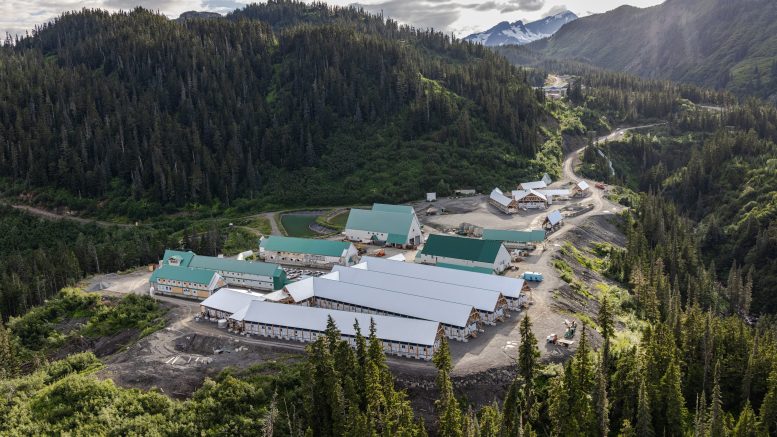Between 1988 and 2008, the Eskay Creek mine in northwest B.C. produced about 3.3 million oz. gold and 160 million oz. silver, boasting the world’s highest average grades of 45 grams gold per tonne and 2,224 grams silver per tonne.
Almost a decade after it shut down due to high operating costs and a relatively low gold price, Skeena Resources (TSX: SKE, NYSE: SKE) acquired the property with the goal of restarting the mine, located in Tahltan territory.
Skeena’s CEO Walter Coles Jr. told The Northern Miner that early studies on the project, located about 83 km northwest of Stewart, suggest a significant reduction in both operating costs at the mine and in the economic cut-off grade compared to the previous operation.
“The big twist that we brought to the project was to look at it as an open pit where historically it was an underground mine,” said Coles. “Historically they were using anywhere between 13 to 15 [grams gold per tonne] cut-off grade, and we are now able to drop that… down to a gram. All that material between a gram and 15 grams that historically was called waste is now ore.”
The province wasn’t very supportive of open pit mining in the early 2000s, said Coles, but a change in policies in the last 15 years allowed Skeena to take a new route.
Utilizing the hydro-electric facilities built near the project site by Calgary-based Alta Gas in 2014 would also decrease operating costs by as much as 45%, the CEO predicts.
“The project was powered by diesel and propane, and I am told that in the early 2000s when the price of oil hit US$100 a barrel, energy represented as much as 50% of their operating cost. Now, with cheap hydro, energy should be less than 5% of the operating cost,” said Cole.
As per the 2021 prefeasibility study, the project’s mill will run on hydro-electric power, but the trucks and shovels will depend upon diesel. It envisages average annual production of 249,000 oz. gold and 7.2 million oz. silver over a 9.8-year mine life at an all-in sustaining cost of US$548 per oz. gold-equivalent.
At a 5% discount rate, and using metal prices of US$1,550 per oz. gold and US$22 per oz. silver, the project would generate a post-tax net present value of $1.4 billion and an internal rate of return of 56%. The company, which has conducted about 100,000 metres of drilling since acquiring the property in 2018, expects to complete a feasibility study in a couple of months.
‘Ground-breaking’ permitting process
Currently Skeena is working with the Tahltan Nation and the British Columbia to get the environmental assessment approval through a relatively new process where the First Nation will have the legal decision-making authority for the permit as per Section 7 of the Declaration on the Rights of Indigenous Peoples Act (DRIPA), which the B.C. government passed into provincial law in 2019.
“The Tahltan Central Government (TCG) and the province are negotiating the first consent-based decision-making agreement ever to be negotiated under Section 7,” Ombrielle Neria, a TCG spokesperson said. “This means that, for the first time ever in history… B.C. legally acknowledges that a First Nation has… authority and the right to consent to resource development projects in their territory.”
Neria said that the TCG and B.C. are in talks to reach an agreement related to the environment assessment approvals for two projects in its territory — the Eskay Creek mine and the expansion of Newcrest Mining (TSX: NCM; ASX: NCM) and Imperial Metals’ (TSX: III) Red Chris mine.
“This work is ground-breaking. It should be recognized, championed, and celebrated,” Neria added.
Explaining the process, Coles said that instead of going to the B.C. government for approval, the company “turned around” the process and consulted the Tahltan Nation first. Once Skeena gets the approval, it will go to the government.
“We have done that for every step of the way, exploration permits, camp permits,” said Coles. “We are kind of the first to go through this formal process with the Tahltan.”
The process will compel mining companies to have a strong support from First Nations, said the CEO. “If you don’t have… you will probably not get your permits in B.C.”
Deena Tokaryk, a spokesperson for the Tahltan Nation Development Corporation (TNDC), the business arm of the Tahltan Nation, said that the TNDC’s work on the project has helped improve the employment numbers of Tahltan members.
Tokaryk also mentions that the TNDC, which returns profits to its Tahltan shareholders including the Tahltan government, has been involved in several phases of the project including exploration, geotechnical drilling, modification of camp building designs and carrying out environmental assessment work.
As the company advances the project, Cole says his team will be excited to build and operate the mine in the future. However, Skeena will also be open to acquisition offers for the project, which has proven and probable reserves of 26.4 million tonnes grading 3.37 grams gold per tonne, 94 grams silver for a contained metal of 2.9 million oz. gold and 80.2 million oz. silver.
“There’s been a lot of consolidation already in the gold sector and I expect there will be more. It’s always possible the Skeena will participate in that consolidation,” he said.


Be the first to comment on "Skeena involved in ‘ground-breaking’ permit process at Eskay Creek "